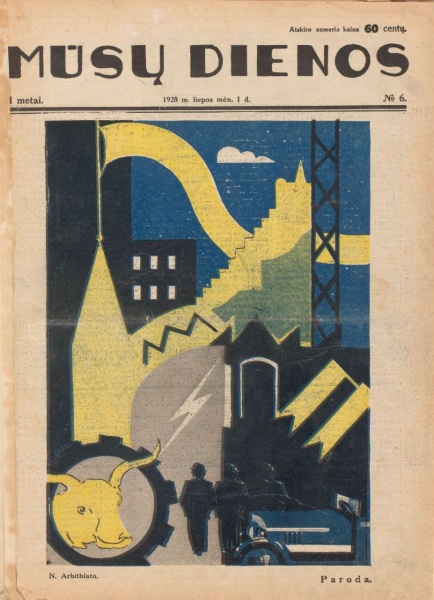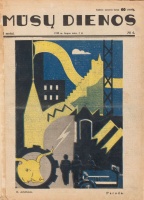
Reproduction of the work Exhibition by Arbit Blatas on the cover of the magazine Mūsų dienos, No 6
| Author: |
Neemiya Arbitblatas (1908–1999)  |
| Created: | 1928 |
| Material: | paper |
| Technique: | colour printing |
| Dimensions: | 0 cm |
Kaunas, the interim capital, was a growing city. Art and architecture were often used for the purpose of promoting the young state. Although ethnographic elements prevailed, other symbolic images that summed up the Lithuanian identity were also used. While the residents of Kaunas wanted to view their capital as a modern European city, rural culture, which was seen as preserving the Lithuanian spirit, was combined with the history of the Grand Duchy of Lithuania.
The link between national and modern Kaunas is clear in the medal that Adomas Galdikas (1893–1969) designed for the Lithuanian Agriculture and Industry Exhibition. A Modernist vision of Kaunas is also evoked in a reproduction of the work Exhibition by Arbit Blatas (1908–1999). It shows a radiophone tower and stylishly dressed people beside a luxury car, while Taurus, the symbol of Kaunas, is integrated into a cogwheel, a feature of industry, which also appears in Galdikas’ medal. Thus, the image of Kaunas was not as plain as it might at first appear, for its creators drew not only on ethnography, but also on old classics, romantic Historicism and ideas of progress and modernisation, which coincided with people’s outlook during the interwar period.
Text authors Dovilė Barcytė and Ieva Burbaitė
Kaunas, the temporary capital. After the Great War and the struggle for Vilnius, in 1920 the city and the region became part of Poland. Kaunas became the temporary capital and grew rapidly. Its importance as a political, economic and cultural centre increased. Lithuanians and Jews began to forge closer ties under the slogan ‘Let all flowers bloom!’ The Jewish community actively supported the aspirations of the independent Republic of Lithuania, and Jewish artists also contributed to the modernisation of the country. Arbit Blatas and Lasar Kagan were particularly active on the art scene. In 1928, Blatas participated in the Anniversary Exhibition of Works by Lithuanian Artists organised in Kaunas by the Lithuanian Art Society.
The magazine Mūsų dienos (1928, No 6) published an article about the exhibition, and used a Futurist composition by 19-year-old Arbit Blatas for the cover, representing the new identity of Lithuania, which connected the country’s past, its present and its future, and its national (rural and modern urban) culture. An aurochs, the symbol of Kaunas, is incorporated into a gear wheel, symbolising technology and industry. The silhouette of the historic castle beside the radio transmission tower, a transformer station, some high-rise buildings and a car, express the goals of the First Republic of Lithuania.
Text author Vilma Gradinskaitė
Source: Law firm Valiunas Ellex art album KAUNAS–VILNIUS / 1918–1945 (2021). Compilers and text authors Dovilė Barcytė and Ieva Burbaitė, STORIES OF LITVAK ART (2023). Compiler and author Vilma GradinskaitėExpositions: "1918-1945 / Kaunas-Vilnius", 27 August 2020 – 21 August 2021, Lithuanian Art Centre TARTLE (Užupio St. 40, Vilnius). Curators Dovilė Barcytė and Ieva Burbaitė.







